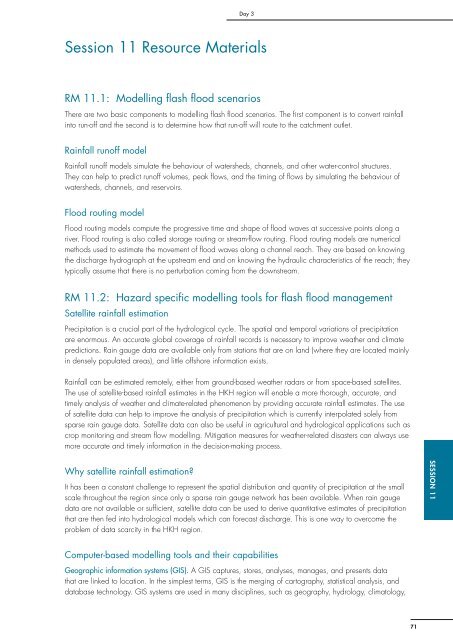Flash Flood Risk Management â A Training of Trainers ... - ReliefWeb
Flash Flood Risk Management â A Training of Trainers ... - ReliefWeb
Flash Flood Risk Management â A Training of Trainers ... - ReliefWeb
You also want an ePaper? Increase the reach of your titles
YUMPU automatically turns print PDFs into web optimized ePapers that Google loves.
Day 3<br />
Session 11 Resource Materials<br />
RM 11.1: Modelling flash flood scenarios<br />
There are two basic components to modelling flash flood scenarios. The first component is to convert rainfall<br />
into run-<strong>of</strong>f and the second is to determine how that run-<strong>of</strong>f will route to the catchment outlet.<br />
Rainfall run<strong>of</strong>f model<br />
Rainfall run<strong>of</strong>f models simulate the behaviour <strong>of</strong> watersheds, channels, and other water-control structures.<br />
They can help to predict run<strong>of</strong>f volumes, peak flows, and the timing <strong>of</strong> flows by simulating the behaviour <strong>of</strong><br />
watersheds, channels, and reservoirs.<br />
<strong>Flood</strong> routing model<br />
<strong>Flood</strong> routing models compute the progressive time and shape <strong>of</strong> flood waves at successive points along a<br />
river. <strong>Flood</strong> routing is also called storage routing or stream-flow routing. <strong>Flood</strong> routing models are numerical<br />
methods used to estimate the movement <strong>of</strong> flood waves along a channel reach. They are based on knowing<br />
the discharge hydrograph at the upstream end and on knowing the hydraulic characteristics <strong>of</strong> the reach; they<br />
typically assume that there is no perturbation coming from the downstream.<br />
RM 11.2: Hazard specific modelling tools for flash flood management<br />
Satellite rainfall estimation<br />
Precipitation is a crucial part <strong>of</strong> the hydrological cycle. The spatial and temporal variations <strong>of</strong> precipitation<br />
are enormous. An accurate global coverage <strong>of</strong> rainfall records is necessary to improve weather and climate<br />
predictions. Rain gauge data are available only from stations that are on land (where they are located mainly<br />
in densely populated areas), and little <strong>of</strong>fshore information exists.<br />
Rainfall can be estimated remotely, either from ground-based weather radars or from space-based satellites.<br />
The use <strong>of</strong> satellite-based rainfall estimates in the HKH region will enable a more thorough, accurate, and<br />
timely analysis <strong>of</strong> weather and climate-related phenomenon by providing accurate rainfall estimates. The use<br />
<strong>of</strong> satellite data can help to improve the analysis <strong>of</strong> precipitation which is currently interpolated solely from<br />
sparse rain gauge data. Satellite data can also be useful in agricultural and hydrological applications such as<br />
crop monitoring and stream flow modelling. Mitigation measures for weather-related disasters can always use<br />
more accurate and timely information in the decision-making process.<br />
Why satellite rainfall estimation?<br />
It has been a constant challenge to represent the spatial distribution and quantity <strong>of</strong> precipitation at the small<br />
scale throughout the region since only a sparse rain gauge network has been available. When rain gauge<br />
data are not available or sufficient, satellite data can be used to derive quantitative estimates <strong>of</strong> precipitation<br />
that are then fed into hydrological models which can forecast discharge. This is one way to overcome the<br />
problem <strong>of</strong> data scarcity in the HKH region.<br />
session 11<br />
Computer-based modelling tools and their capabilities<br />
Geographic information systems (GIS). A GIS captures, stores, analyses, manages, and presents data<br />
that are linked to location. In the simplest terms, GIS is the merging <strong>of</strong> cartography, statistical analysis, and<br />
database technology. GIS systems are used in many disciplines, such as geography, hydrology, climatology,<br />
71

















